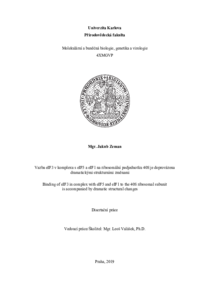Binding of eIF3 in complex with eIF5 and eIF1 to the 40S ribosomal subunit is accompanied by dramatic structural changes
Vazba eIF3 v komplexu s eIF5 a eIF1 na ribosomální podjednotku 40S je doprovázena dramatickými strukturními změnami
dizertační práce (OBHÁJENO)

Zobrazit/
Trvalý odkaz
http://hdl.handle.net/20.500.11956/109912Identifikátory
SIS: 145399
Katalog UK: 990022941950106986
Kolekce
- Kvalifikační práce [21483]
Autor
Vedoucí práce
Oponent práce
Štefl, Richard
Man, Petr
Fakulta / součást
Přírodovědecká fakulta
Obor
-
Katedra / ústav / klinika
Katedra genetiky a mikrobiologie
Datum obhajoby
11. 9. 2019
Nakladatel
Univerzita Karlova, Přírodovědecká fakultaJazyk
Angličtina
Známka
Prospěl/a
Klíčová slova (česky)
eIF3, iniciace translace, ribosom, chemické zesítění spojené s hmotnostní spektrometrií, strukturní biologieKlíčová slova (anglicky)
eIF3, translation initiation, ribosome, cross-linking coupled with mass spectrometry, structural biologyEukaryotické iniciační faktory (eIF) jsou pro průběh eukaryotické translace minimálně stejně důležité jako ribosom. Některé tyto faktory mají rozdílné úlohy napříč celou translací v zajištění korektního složení preiniciačního komplexu na mRNA, přesném výběru iniciačního kodonu, bezchybné produkci příslušného polypeptidu a jejím řádném ukončení. Patrně nejdůležitějším z těchto faktorů je eIF3, který integruje signály od ostatních faktorů a koordinuje jejich funkci na ribosomu. V případě Saccharomyces cerevisiae je eIF3 tvořen pěti podjednotkami. Všechny tyto podjednotky obsahují strukturní motivy zodpovědné za kontakt s ribosomálními proteiny a molekulami RNA. Kromě těchto vysoce strukturovaných částí je zbytek eIF3 nestrukturovaný a velmi flexibilní. Z toho důvodu nejsou i přes současný pokrok v kryoelektronové mikroskopii doposud známy ani přesná struktura eIF3, ani jeho přesná poloha na ribosomální podjednotce 40S. Rovněž přítomnost eIF3 na ribosomu 80S během časné elongace a role eIF3 v reiniciaci a pročítání stop kodonu nejsou zatím zcela prostudovány. K rozluštění těchto tajemství eIF3 jsme použili rentgenovou krystalografii, chemické zesítění spojené s hmotnostní spektrometrií a rozličné biochemické a genetické metody. Naše práce ukazuje, že je eIF3 velmi kompaktně sbalený, pokud se nachází...
In eukaryotic translation, eukaryotic initiation factors (eIFs) are at least as important as the ribosome itself. Some of these factors play different roles throughout the entire process to ensure proper assembly of the preinitiation complex on mRNA, accurate selection of the initiation codon, errorless production of the encoded polypeptide and its proper termination. Perhaps, the most important factor integrating signals from others and coordinating their functions on the ribosome is eIF3. In Saccharomyces cerevisiae, eIF3 is formed by five subunits. All these subunits contain structural motifs responsible for contact with ribosomal proteins and RNAs. In addition to these highly structured parts, the rest of eIF3 is unstructured and very flexible. Therefore, despite the recent progress thanks to the use of a cryo-electron microscopy, a precise structure and position of eIF3 on the 40S ribosomal subunit are still not known. Also, the presence of eIF3 on 80S during early elongation and its role in reinitiation and readthrough are not fully understood. In order to crack mysteries of yeast eIF3, we used x-ray crystallography, chemical cross- linking coupled to mass spectrometry, and various biochemical and genetic assays. We demonstrated that eIF3 is very compactly packed when free in solution. This...
